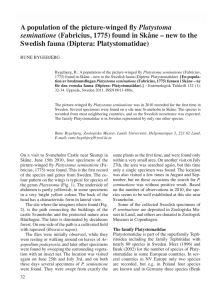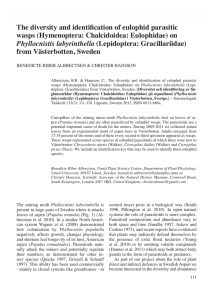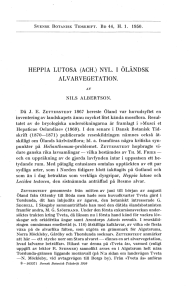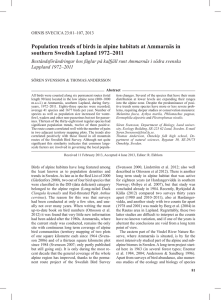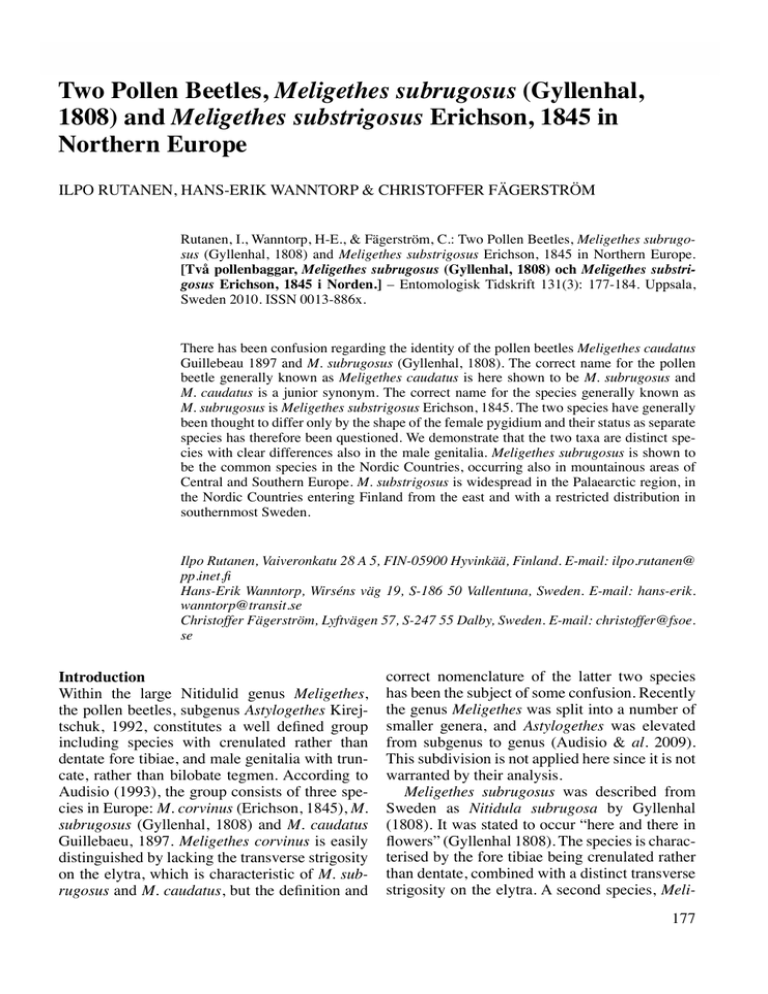
Ent. Tidskr. 131 (2010)
Two pollen beetles: Melighetes subrugosus and M. substrigosus
Two Pollen Beetles, Meligethes subrugosus (Gyllenhal,
1808) and Meligethes substrigosus Erichson, 1845 in
Northern Europe
iLPO RUTANEN, HANS-ERIK WANNTORP & CHRISTOFFER FÄGERSTRÖM
Rutanen, I., Wanntorp, H-E., & Fägerström, C.: Two Pollen Beetles, Meligethes subrugosus (Gyllenhal, 1808) and Meligethes substrigosus Erichson, 1845 in Northern Europe.
[Två pollenbaggar, Meligethes subrugosus (Gyllenhal, 1808) och Meligethes substrigosus Erichson, 1845 i Norden.] – Entomologisk Tidskrift 131(3): 177-184. Uppsala,
Sweden 2010. ISSN 0013-886x.
There has been confusion regarding the identity of the pollen beetles Meligethes caudatus
Guillebeau 1897 and M. subrugosus (Gyllenhal, 1808). The correct name for the pollen
beetle generally known as Meligethes caudatus is here shown to be M. subrugosus and
M. caudatus is a junior synonym. The correct name for the species generally known as
M. subrugosus is Meligethes substrigosus Erichson, 1845. The two species have generally
been thought to differ only by the shape of the female pygidium and their status as separate
species has therefore been questioned. We demonstrate that the two taxa are distinct species with clear differences also in the male genitalia. Meligethes subrugosus is shown to
be the common species in the Nordic Countries, occurring also in mountainous areas of
Central and Southern Europe. M. substrigosus is widespread in the Palaearctic region, in
the Nordic Countries entering Finland from the east and with a restricted distribution in
southernmost Sweden.
Ilpo Rutanen, Vaiveronkatu 28 A 5, FIN-05900 Hyvinkää, Finland. E-mail: ilpo.rutanen@
pp.inet.fi
Hans-Erik Wanntorp, Wirséns väg 19, S-186 50 Vallentuna, Sweden. E-mail: hans-erik.
wanntorp@transit.se
Christoffer Fägerström, Lyftvägen 57, S-247 55 Dalby, Sweden. E-mail: christoffer@fsoe.
se
Introduction
Within the large Nitidulid genus Meligethes,
the pollen beetles, subgenus Astylogethes Kirejtschuk, 1992, constitutes a well defined group
including species with crenulated rather than
dentate fore tibiae, and male genitalia with truncate, rather than bilobate tegmen. According to
Audisio (1993), the group consists of three species in Europe: M. corvinus (Erichson, 1845), M.
subrugosus (Gyllenhal, 1808) and M. caudatus
Guillebaeu, 1897. Meligethes corvinus is easily
distinguished by lacking the transverse strigosity
on the elytra, which is characteristic of M. subrugosus and M. caudatus, but the definition and
correct nomenclature of the latter two species
has been the subject of some confusion. Recently
the genus Meligethes was split into a number of
smaller genera, and Astylogethes was elevated
from subgenus to genus (Audisio & al. 2009).
This subdivision is not applied here since it is not
warranted by their analysis.
Meligethes subrugosus was described from
Sweden as Nitidula subrugosa by Gyllenhal
(1808). It was stated to occur “here and there in
flowers” (Gyllenhal 1808). The species is characterised by the fore tibiae being crenulated rather
than dentate, combined with a distinct transverse
strigosity on the elytra. A second species, Meli177
Ilpo Rutanen, Hans-Erik Wanntorp & Christoffer Fägerström
Ent. Tidskr. 131 (2010)
b
a
Figure 1. – a) Meligethes substrigosus, male (Sweden Blekinge, Asarum); – b) M. subrugosus, female Öland,
Fagerrör.
– a) Meligethes substrigosus, hane (Sverige Blekinge, Asarum); – b) M. subrugosus, hona (Sverige, Öland,
Fagerrör).
a
b
Figure 2. Pygidium of females of – a) Meligethes subrugosus; – b) M. substrigosus, Photo C. Fägerström.
Pygidium av honor – a) Meligethes subrugosus; – b)
M. substrigosus. Foto C. Fägerström.
gethes substrigosus, was described by Erichson
(1845), but was later considered a synonym of
M. subrugosus (e.g. Audisio 1993). Gyllenhal’s
species was interpreted as identical to a species
that is widespread in Europe (e.g. Erichson 1845,
Reitter 1871, Spornraft 1967, Audisio 1993). In
1897 a third, closely related species Meligethes
caudatus was described from the French Alps
178
by F. Guillebeau (Guillebeau 1897). The new
species was described as similar to M. subrugosus, but with a distinctly pointed pygidium in
the female. However, Guillebeau’s species was
largely ignored by subsequent workers until
it was recognised as a distinct species by Audisio (1993). Audisio mentions verified records
of M. caudatus from the Alps, the Carpathians
and the Nordic countries (specified localities in
Denmark and Norway, and a dot on the map in
southern Sweden), but retained M. subrugosus
as a species distributed over all of Europe including the Nordic countries. Later, Sörensson
(1999) demonstrated that most of, if not all, the
Swedish material, earlier attributed to M. subrugosus, belonged to M. caudatus (sensu Audisio
1993). Finally, Kurochkin & Kirejtshuk (2005)
again reduced M. caudatus to a synonym of M.
subrugosus.
As a result, confusion reigns regarding the
definition of species and the correct nomencla-
Ent. Tidskr. 131 (2010)
a
d
Two pollen beetles: Melighetes subrugosus and M. substrigosus
b
c
Figure 3. Aedoeagus of Meligethes substrigosus (left) and M. subrugosus (right). – a)
oblique lateral view; – b) lateral view; –
c) dorsal view of apex; – d) dorsal view of
base; – e) tegmen, ventral view. Photo C.
Fägerström.
e
Aedoeagus av Meligethes substrigosus (till
vänster) och M. subrugosus (till höger). –
a) snett från sidan; – b) från sidan; – c)
spetsen uppifrån; – d) basen uppifrån; – e)
tegmen underifrån. (Foto C. Fägerström).
ture within this group. In this paper we address
three separate questions: 1) What is the identity
of Gyllenhal’s species M. subrugosus? 2) Are
M. caudatus and M. subrugosus separate species? 3) What is the distribution of these taxa in
Northern Europe?
a
Material and methods
In order to address these questions we investigated as much of the material of the two species from Finland and Sweden as we could assemble. All material in the museums of Stockholm, Lund, Gothenburg, Helsinki, Turku and
b
Figure 4. Distribution of – a) Meligethes subrugosus, and – b) M. substrigosus in Sweden and Finland based
on specimens examined by us. The Swedish maps are from “the recording system of terrestrial and limnic invertebrates”. The Finnish maps were prepared by the “Finnish Bird Atlas”.
Utbredningen av – a) Meligethes subrugosus och – b) M. substrigosus i Sverige och Finland baserad på exemplar undersökta av oss. De svenska kartorna är från Artportalen, de finska har framställts av Finsk fågelatlas.
179
Ilpo Rutanen, Hans-Erik Wanntorp & Christoffer Fägerström
Oulu was investigated, as well as much material from private collections (in all more than
800 specimens). Additionally, some eighty or
ninety specimens collected from the Russian
part of Fennoscandia, and from Estonia were
examined. The type material of M. subrugosus
(Gyllenhal) and M. substrigosus Erichson was
studied. We also, but to a lesser extent, investigated material from Norway and Denmark, as
well as from most parts of the Palaearctic region. A considerable number of specimens were
genitally dissected. Swedish maps are from the
“Reporting System for Terrestrial and Limnic
Invertebrates” (Artportalen), Finnish maps are
from the “Finnish Bird Atlas”.
Results
The identity of Meligethes subrugosus (Gyllenhal, 1808)
In the Gyllenhal collection at The Museum of
Evolution in Uppsala there are three specimens
of Meligethes subrugosus in the type collection,
one female and two males, all without original labels. The female has a pointed pygidium
and is clearly conspecific with M. caudatus.
Preparation of the genitalia demonstrated that
the males also belong to the same species. Obviously Gyllenhal’s species, M. subrugosus, is
conspecific with M. caudatus, and not with M.
subrugosus sensu Audisio (1993). This result is
in accordance with the observation by Sörensson (1999), that M. caudatus is by far is the most
common and widespread of the two species in
Sweden. The fact that Gyllenhal’s species has
been erroneously interpreted by subsequent
Central European authors is part of a recurrent
pattern (see e.g. Wanntorp 2008).
While Gyllenhal’s epithet has been, mistakenly, adopted for another species for a long
time, the correct identification has been retained
by Nordic authors, such as Thomson (1862),
Hansen (1950) and Lundberg (1995). The
name Meligethes caudatus, on the other hand
has been used by few authors. There is therefore no case for conservation of the latter name
according to ICZN Article 23.9 (1999) and in
spite of the widespread mistaken identification
of the species, Gyllenhal’s epithet must prevail. Meligethes subrugosus (Gyllenhal, 1808)
180
Ent. Tidskr. 131 (2010)
should therefore be used for the species generally named Meligethes caudatus Guillebeau,
1897 and the latter name should be considered a
junior synonym.
For the species commonly identified as Meligethes subrugosus outside Scandinavia, the
name Meligethes substrigosus Erichson 1845
is available (Audisio 1993). In order to confirm
this, we investigated Erichson’s type material,
which is preserved in Berlin. Five specimens
labelled as syntypes are preserved in the historical collection. The male genitalia were extracted
from one male. Both aedoeagus and tegmen is
identical to that of M. subrugosus (auct.) (Fig.
3). Erichson gives the size of M. substrigosus to
be 1-1.5 mm and “mostly half as big as M. subrugosus”. The specimens mentioned, however,
range from 1.4 to 2.1 mm, which is well within
the range given for M. subrugosus (auct.) (Audisio 1993). The name of the species, commonly
referred to as M. subrugosus (Gyllenhal, 1808)
should thus be M. substrigosus Erichson, 1845.
Typification
Meligethes subrugosus (Gyllenhal, 1808)
Type material: a male, originally mounted on
a thin pin, labelled “Uppsala Univ. Zool. Mus.
Gyllenhals saml. TYP nr. 1170 b”. Lectotype,
here designated. Paratypes: a female with the
number 1170 a, and a male with the number
1170 c.
Synonym: Meligethes caudatus Guillebeau,
1897.
Meligethes substrigosus Erichson, 1845
Type material: a male originally glued to a small
triangle, mounted on a pin with one label with
printed number “8546”; one label handwritten,
“substrigosus Er. Austr. Ullr. Schüpp.”; one label printed “Hist.-Coll. (Coleoptera) Nr. 8546
Meligethes substrigosus Erichs. Austria Ullrich
Schüppel Zool. Mus. Berlin”; one label, red,
printed “SYNTYPUS Meligethes substrigosus
Erichson 1845 labelled by MNHUB 2010”. Lectotype here designated. Paratypes: four specimens with the same number and printed labels
but without handwritten label.
Synonym: Meligethes subrugosus auct. non
Gyllenhal
Ent. Tidskr. 131 (2010)
Two pollen beetles: Melighetes subrugosus and M. substrigosus
Identification of the two species.
Obviously, Meligethes subrugosus (Gyllenhal
1808) and M. caudatus Guillebeau 1897 are
conspecific, and the correct name for M. subrugosus auctt. is M. substrigosus Erichson 1845.
The question whether the two latter are separate
species remains to be settled, as do their distribution in the Nordic countries. To answer these
questions we investigated as much material
from Finland and Sweden as we could obtain.
According to Guillebeau (1897) the main
character separating the two species is the apiculate pygidium of the females in M. subrugosus.
According to Audisio (1993) the males also have
a less narrow, but still rather distinctly prominent
pygidium tip. He could find no differences in the
genitalia of the two species. Recently Kurochkin & Kirejtshuk (2005) synonymised the two
species, considering the apiculate pygidium in
some females to represent an extreme in a morphological continuum of one variable species.
As to external morphology, our results comply with the description of Audisio (1993). Females of the two species are easily separated
by the apiculate pygidium in M. subrugosus
(Gyll.), which contrasts markedly with the
rounded shape in M. substrigosus Er. (Fig. 2).
Males are more difficult. Often the pygidium of
male M. subrugosus has a clearly offset lobate
apex but more blunt than in the females, although this is not always evident. Kurochkin &
Kirejtshuk (2005) report a very great variation
in the shape of the pygidium, which caused them
to merge the two species. Also Sörensson (1999)
comments on the great variation. According to
our investigation, the variation is not considerable and we suspect that this misconception was
caused by not clearly separating the sexes and
the species. There is indeed a continuum of sorts
from female M. subrugosus, to male M. subrugosus, and female M. substrigosus to male M.
substrigosus (Fig. 2), which may make identification difficult from using external characters
alone if the sex is not correctly determined.
Genitalia
According to Audisio (1993), the genitalia in
these two taxa are identical. This is also the
view of Spornraft (1998). In the opinion of these
authors, the sole means of identification is the
outline of the apex of the pygidium, making the
males often difficult to separate. According to
our investigation, the aedoeagus is indeed rather
similar, but only in outline (Fig 3c). Closer investigation shows clear and constant differences. In M. substrigosus, the apex of the aedoeagus
is dorsally flat, or slightly convex with a narrow
central furrow, as shown in Audisio (1993, Fig.
137p). In M. subrugosus, however the apex is
dorsally concave (Fig. 3 a, d). There is also a distinct difference in the profile of the aedoeagus,
which is dorsally uniformly curved in M. subrugosus, while in M. substrigosus it becomes flat
apically, or even bent slightly upwards (Fig. 3b).
The tegmen also differs, being parallel in outline
in M. subrugosus, whereas that of M. substrigosus tapers distinctly towards the apex. There are
also further differences in the tegmen, especially
when viewed ventrally as in Fig. 3e.
In our opinion M. substrigosus and M. subrugosus are clearly distinct species. It has been
argued that the two species can only be identified with certainty in the female sex, but as demonstrated here the differences in male genitalia
permit a reliable identification also of males.
Distribution
In the Nordic countries Meligethes subrugosus
is widely distributed in Sweden and Finland
(Fig. 4a) and also in Denmark (Hansen & al.
1996) and Norway (F. Ødegaard pers. comm.).
According to Audisio (1993) it is also distributed in the Apennine, Alpine and Carpathian
mountain ranges. We have seen material from
Bavaria and from the Hartz in Germany, so it
seems that the species has a wider distribution
in Central Europe.
Meligethes substrigosus is distributed from
Western Europe to eastern Asia. In the Nordic
countries it enters the south-eastern part of Finland. In Sweden, it is only known from a small
area in the counties Skåne and Blekinge in the
south (Fig 4b). It is unknown from Norway and
has not yet been recorded from Denmark (Hansen & al. 1996).
In the collection of the Central Museum of
Natural History, Helsinki, some ten to twenty
181
Ilpo Rutanen, Hans-Erik Wanntorp & Christoffer Fägerström
Ent. Tidskr. 131 (2010)
a
b
Figure 5. – a) Habitat of
Meligethes substrigosus in
Finland with host plant, Campanula glomerata (Photo A -P.
Rutanen); – b) Habitat of M.
substrigosus in Sweden with
the host plant Jasione montana (Photo B. Ericson).
– a) Lokal för Meligethes
substrigosus i Finland med
värdväxten, toppklocka (Foto
A-P. Rutanen); – b) lokal för
M. substrigosus i Sverige med
värdväxten, monke (foto B.
Ericson).
specimens of both species collected from Estonia were found. The majority of these proved to
be M. subrugosus, but also a few M. substrigosus were found.
Both species also occur in the Russian part of
Fennoscandia. In the collection of Helsinki we
identified 45 specimens of M. subrugosus and
26 specimens of M. substrigosus collected in
various localities of this area, from the Karelian
Isthmus in the south along the River Svir up to
Lake Onega. In the collection of the Museum
of Helsinki, we also examined some twenty
specimens collected by Finnish coleopterists in
182
different parts of Siberia during the 19th and beginning of 20th century. This material consisted
entirely of M. substrigosus.
Biology
Both species develop in the flowers of different
Campanulaceae. There are few records of host
plants. Audisio (1993) mentions only Campanula rotundifolia as the host plant for Meligethes
subrugosus. This is also the case in Finland
(personal observations). From Sweden it is recorded from several bellflower species: except
for Campanula rotundifolia, also from C. patula
Ent. Tidskr. 131 (2010)
Two pollen beetles: Melighetes subrugosus and M. substrigosus
and C. trachelium, as well as from Jasione montana (personal observations).
According to Audisio (1993), M. substrigosus is found on different species, mainly Jasione
montana, but also on Campanula glomerata
(Fig. 5), C. trachelium and C. rapunculoides.
In Finland it is only recorded from C. glomerata (personal observation). In Sweden it is only
known from Jasione montana (B. Ericson in.
litt.).
Acknowledgements
Niklas Jönsson, Museum of Natural History, Stockholm, Roy Danielsson, Zoological Museum, Lund,
Charlotte Johnsson, Museum of Natural History,
Gothenburg, and Hans Mejlon, Museum of Evolution, Uppsala, Hans Silfverberg, Central Museum of
Natural History, Helsinki, Veikko Rinne, Zoological
Museum of Turku, Jouni Aspi and Mikko Pentinsaari,
Zoological Museum of Oulu. Many private collectors
gave us access to their material. Without their help
this paper would have been impossible to prepare.
Ari-Pekka Rutanen and Bertil Ericson photographed
the habitats of M. substrigosus. Peter Hodge improved our English. Comments from Josef Jelinek,
Håkan Ljungberg and Mikael Sörensson greatly improved the manuscript. Sincere thanks to all.
References
Audisio, P. 1993. Fauna d’Italia: Coleoptera Nitidulidae – Kateretetidae. – Edizioni Calderini, Bologna.
Audisio, P., Cline, A., R. De Biase, A., Antonini, G.,
Mancini, E., Trizzini, M.,Constantini, L., Strika,
S., Lamanna, F. and Cerretti, P. 2009. Preliminary
re-examination of genus-level taxonomy of the
pollen beetle subfamily Meligethinae (Coleoptera: Nitidulidae). – Acta entomologica Musei
Nationalis Pragae 49(2): 341-504.
Erichson, W.F. 1845. Naturgeschichte der Insekten
Deutschlands: Coleoptera 3. – Berlin.
Guillebeau, F. 1897. Description de quelques espèces nouvelles des Coléoptères. – Bull. Soc. Ent.
France 222-227.
Gyllenhal, L. 1808. Insecta Suecica descripta. Tomus
I. – F.J. Leverentz, Scaris.
Hansen, M., Mahler, V., Palm, E. & Pedersen, J. 1996.
15. Tillæg til ”Fortegnelse over Danmarks Biller”
(Coleoptera). – Ent. Medd. 64: 233-272.
Hansen, V. 1950. Biller XIII Clavicornia 1. – G.E.C.
Gads Forlag, Copenhagen.
ICZN (International Commission of Zoological Nomenclature). 1999. International Code of Zoo-
logical Nomenclature ed. 4. – Natural History
Museum, London.
Kurochkin, A.S. & Kirejtshuk, A.G. 2005. Notes on
the synonymy and distribution of some species of
Meligethes Stephens, 1830 (Coleoptera: Nitidulidae). – Russian Entomol. J. 14: 209-215.
Lundberg, S. 1995. Catalogus Coleopterorum Sueciae. – Naturhistoriska Riksmuseet, Stockholm.
Reitter, E. 1871. Revision der europäischen Meligethes-Arten. – Verh. Nat Ver. Brünn. 9: 39-169.
Sörensson, M. 1999. Rapsbaggen Meligethes caudatus Guillebeau i Sverige. – Ent. Tidskr. 120:127128.
Spornraft, K. 1967. Nitidulidae. – In: Freude, H.,
Harde, K.W. & Lohse, G.A. (eds.). Die Käfer
Mitteleuropas 7. – Goecke & Evers, Krefeld.
Spornraft, K. 1998. Nitidulidae. – In: Lucht, W. &
Klausnitzer, B. (eds.). Die Käfer Mitteleuropas
15. Goecke & Evers, Krefeld.
Thomson, C.G. 1862. Skandinaviens Coleoptera synoptiskt bearbetade Tom. IV. – Lundbergska Boktryckeriet, Lund.
Wanntorp, H-E. 2008. The identity of Mantura obtusata (Gyllenhal 1813) (Coleoptera, Chrysomelidae) – a Nordic-Central European mismatch. –
Ent. Tidskr. 129: 99-101.
Sammanfattning
Pollenbaggen Meligethes subrugosus beskrevs
ursprungligen från Sverige av L. Gyllenhal
(1808). Arten lever på blåklockeväxter och
känns igen på sina tvärritsade täckvingar och
fintandade framtibier. Ute i Europa kom Gyllenhals namn tidigt att användas för en där vanlig
art som stämde med denna beskrivning. Senare
beskrevs en snarlik art från de franska Alperna,
Meligethes caudatus Guillebeau, 1897. Den
skiljer sig från M. caudatus bara genom att honan
har en spetsigt utdragen bakkroppspets. Arten
ignorerades i stort sett, tills Audisio (1993) påvisade att det nog rörde sig om en god art trots att
han inte kunde finna några fler tydliga skillnader
än honans bakkroppspets. Enligt Audisio (1993)
är de hanliga genitalierna hos de två artertna
identiska. Han visade att M. caudatus huvudsakligen förekom i Mellaneuropas bergstrakter
och i Norden. Sörensson (1999) påvisade att M.
caudatus var den vanliga arten i Norden, medan
M. subrugosus inte säkert kunde påvisas. Nyligen förkastade Kurochkin & Kirejtshuk (2005)
M. caudatus. Dessa författare betraktade hela
materialet som tillhörande en enda variabel art,
183
Ilpo Rutanen, Hans-Erik Wanntorp & Christoffer Fägerström
Ent. Tidskr. 131 (2010)
Meligethes caudatus. Vi bestämde oss därför
för att närmare försöka utreda arternas verkliga
status och deras förekomst i Norden. Undersökning av de hanliga genitalierna visade att arterna, trots att Audisio hävdat motsatsen, faktiskt
tydligt skiljer sig i de hanliga genitalierna. Både
Aedoeagus och tegmen uppvisar klara och genomgående skillnader, både inom och utanför
Norden. En undersökning av typmaterialet för
M. subrugosus i Gyllenhals samling i Uppsala
visade, att det, som man kunde förvänta, rörde
sig om den i Sverige vanliga arten som dittills
kallats M. caudatus. Denna måste då byta namn
till M. subrugosus och namnet M. caudatus blir
en yngre synonym. Den art som hittills gått
under namnet M. subrugosus måste få ett nytt
namn. Den skall i stället heta M. substrigosus
Erichson, 1845. Lectotyper har utsetts för båda
arterna i Gyllehals och Erichsons samlingar. En
genomgång av omkring 1000 exemplar i nordiska samlingar visade att M. subrugosus är vitt
spridd, medan M. substrigosus i Norden bara
förekommer i sydöstra delarna av Finland samt
i ett begränsat område i Skåne och Blekinge i
Sverige. Meligethes subrugosus förekommer på
flera olika arter av blåklockeväxter. M. substrigosus däremot, är i Finland bara konstaterad på
toppklocka, en art som i Sverige är ursprunglig
bara i östra Svealand. I Sverige är M. substrigosus ännu bara säkert funnen på monke.
Maria och Thure Palms minnesfond
samt Överbys fond
Stipendier från Entomologiska
föreningen i Uppland
Flera stipendier på tillsammans c:a 20 000 kronor kan sökas av framför allt yngre entomologer
men även doktorander eller motsvarande. Stipendierna är avsedda för ett självständigt arbete
rörande insekter. Noggrann plan fordras rörande
entomologiska undersökningen vartill medel
söks. Kostnadskalkyl skall bifogas, liksom också yttrande över eleven från handledare, lärare
i naturkunskap eller motsvarande. Om medel
söks från annat håll skall detta anges.
Eventuella frågor kan besvaras av Bert Gustafsson, tel. 08 5195 4089, e-mail bert.gustafsson@nrm.se.
Ansökan inlämnas till föreningen senast 1
maj 2011 under adress:
Stipendier på totalt ca 30 000 kronor ur 4 olika
fonder kan sökas av främst yngre entomologer i
skolålder (ej antagen till doktorandutbildning).
En mindre del av totalbeloppet är även öppet för
doktorander eller motsvarande. Stipendierna är
avsedda för ett självständigt arbete rörande insekter. Plan på arbetet och kostnadskalkyl ska
bifogas ansökan. Om medel söks från annat håll
ska detta anges. Ange dessutom ett konto där
beviljade medel kan sättas in. Resultatet av undersökningen redovisas skriftligen eller muntligen under någon av föreningens ordinarie sammankomster.
Eventuella frågor besvaras av Stefan Eriksson tel. 018-501559, e-post: stefaneriksson@
eurofins.se
Ansökan skall vara föreningen tillhanda senast den 30 april 2011. Adress: Entomologiska
föreningen i Uppland, c/o Stefan Eriksson,
Järsta Lugnet 141, 743 93 Vattholma.
Mer information på: www.insekteriuppland.
se. På hemsidan ligger en färdig mall som kan
användas för ansökan.
Entomologiska föreningen
Naturhistoriska riksmuseet
Box 50007
104 05 Stockholm
184

